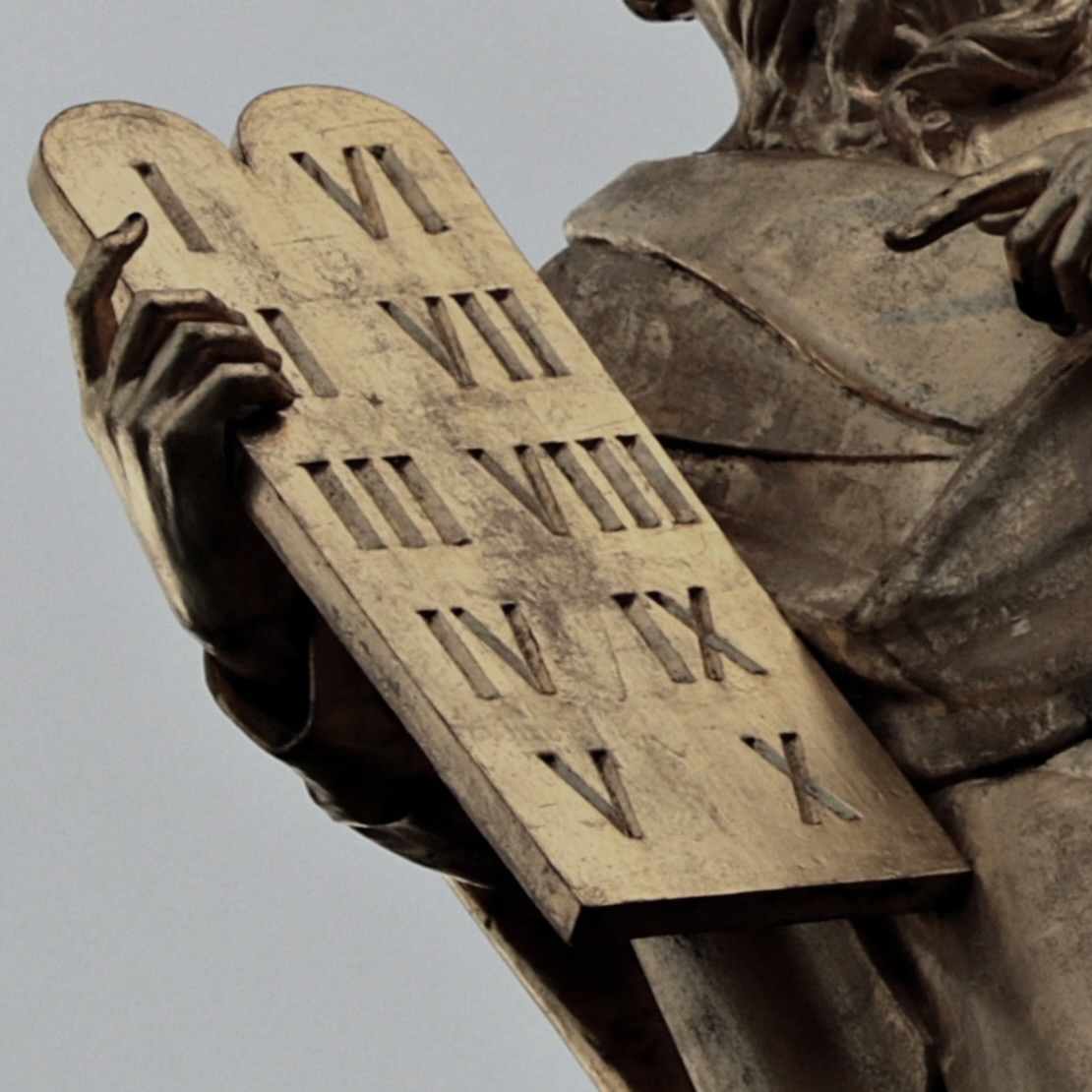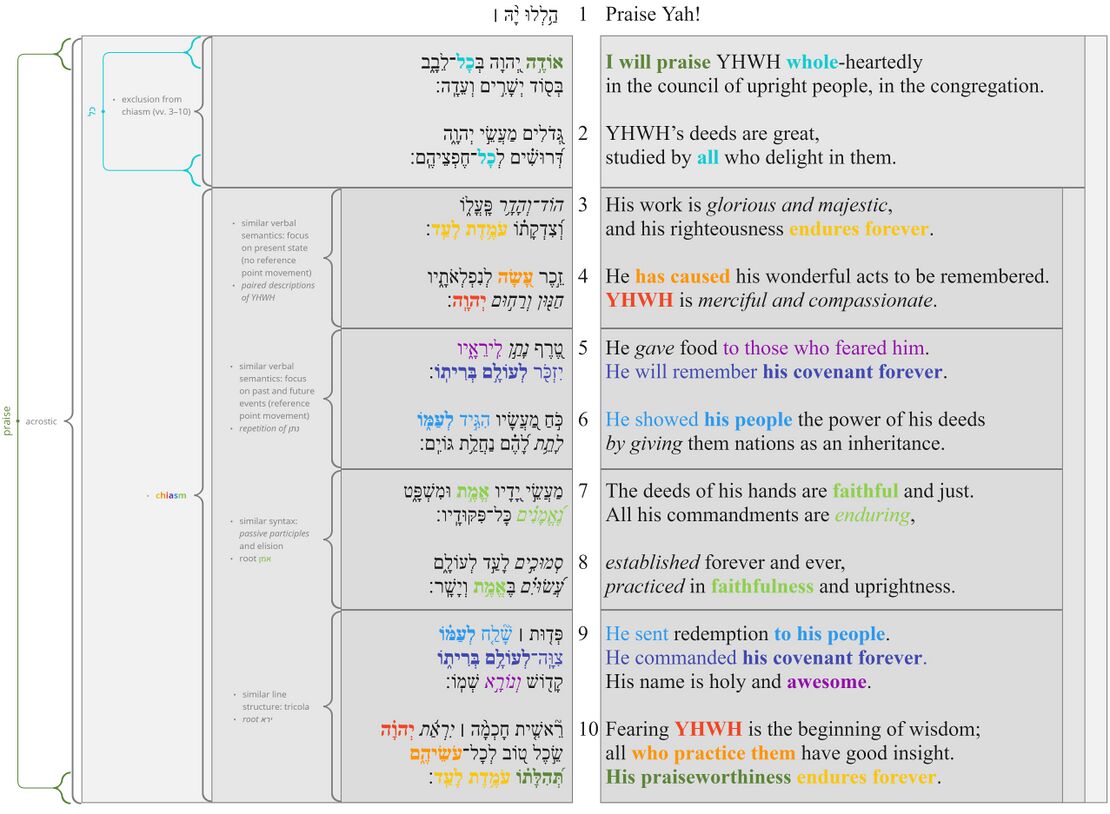Psalm 111 Poetic Structure
Poetic Structure
In poetic structure, we analyse the structure of the psalm beginning at the most basic level of the structure: the line (also known as the “colon” or “hemistich”). Then, based on the perception of patterned similarities (and on the assumption that the whole psalm is structured hierarchically), we argue for the grouping of lines into verses, verses into sub-sections, sub-sections into larger sections, etc. Because patterned similarities might be of various kinds (syntactic, semantic, pragmatic, sonic) the analysis of poetic structure draws on all of the previous layers (especially the Discourse layer).
Poetic Macro-structure
If an emendation or revocalization is preferred, that emendation or revocalization will be marked in the Hebrew text of all the visuals.
| Emendations/Revocalizations legend | |
|---|---|
| *Emended text* | Emended text, text in which the consonants differ from the consonants of the Masoretic text, is indicated by blue asterisks on either side of the emendation. |
| *Revocalized text* | Revocalized text, text in which only the vowels differ from the vowels of the Masoretic text, is indicated by purple asterisks on either side of the revocalization. |
Notes
- vv. 3–10. The major division in the psalm is between vv. 1–2 and vv. 3–10. This division is based primarily on the chiasm that spans vv. 3b–10c (see poetic feature #2). Although it is not part of the chiasm, v. 3a is joined to the unit of vv. 3b–10a by means of both syntax (conjunctive waw in v. 3b) and prosody (v. 3 is a single prosodic unit, a Masoretic verse). The unit consisting of vv. 3–10 is subdivided into four smaller units of two verses each (cf. van der Lugt 2014:235).
- vv. 3–4. The first subunit is united by similar verbal semantics. Each clause in this unit shows a lack of reference point movement: "is... stands... has caused... is." In each clause (even the one clause that uses a qatal verb), the focus is on the present/resultant state. The unit is further united by the repetition—at the beginning and end of the unit—of pairs of words praising YHWH: הוֹד־וְהָדָ֥ר (v. 3a) and חַנּ֖וּן וְרַח֣וּם (v. 4b) (cf. van der Lugt 2014:236).
- vv. 5–6. In vv. 5–6, all of the main verbs have reference point movement: "he gave... he will remember... he showed..." Whereas the focus of the previous unit was on present states, the focus of this unit is on YHWH's past actions (vv. 5a, 6ab) and their future implications (v. 5b). The verb נתן also occurs in the first and last line of this unit (cf. Auffret 1997; van der Lugt 2014:236).
- vv. 7–8. The third subunit may be the most clearly defined. This unit is formed by the repetition of the root אמן, the repetition of passive participles (vv. 7b, 8a, 8b) and the fact that כָּל־פִּקּוּדָֽיו is the subject in three out of the four lines (vv. 7b, 8a, 8b). Furthermore, the unit is framed, like vv. 3–4, by pairs of words joined by waw: אֱמֶ֣ת וּמִשְׁפָּ֑ט (v. 7a) and בֶּאֱמֶ֥ת וְיָשָֽׁר (v. 8b).
- vv. 9–10. The fourth sub-unit is united by the fact that these two verses are the only two tricola in the psalm. They are further stitched together by the repetition of the root ירא at the end of v. 9 and the beginning of v. 10.
- vv. 1–2. The first two verses of the psalm form a unit. They are united not only by their exclusion from the chiasm (vv. 3–10), but also by the repetition of כל at the beginning and end of the unit (vv. 1a, 2b). Together, these two verses serve as a kind of introduction to the psalm. In v. 1, the psalmist states his intention to "praise YHWH", and in v. 2 he states the main theme of his praise: "YHWH's deeds" (v. 2a) and the human response to them (v. 2b) (cf. Scoralick 1997:198).
- The whole psalm is framed by an inclusio (words belonging to the semantic domain of praise: אודה and תהלתו). The word תהלתו in v. 10c also corresponds to the superscription הַ֥לְלוּ יָ֨הּ ׀.
- The structural analysis above agrees with van der Lugt (2014) in terms of the division of smaller units (vv. 1–2; vv. 3–4; vv. 5–6; vv. 7–8; vv. 9–10) but with Scoralick (1997) in terms of the division of larger units (vv. 1–2; vv. 3–10). For other structural analyses, see Auffret 1997, Weber 2003, Fokkelman 2003, Kiel 2022.
Line Divisions
Line division divides the poem into lines and line groupings. We determine line divisions based on a combination of external evidence (Masoretic accents, pausal forms, manuscripts) and internal evidence (syntax, prosodic word counting and patterned relation to other lines). Moreover, we indicate line-groupings by using additional spacing.
When line divisions are uncertain, we consult some of the many psalms manuscripts which lay out the text in lines. Then, if a division attested in one of these manuscripts/versions influences our decision to divide the text at a certain point, we place a green symbol (G, DSS, or MT) to the left of the line in question.
| Poetic line division legend | |
|---|---|
| Pausal form | Pausal forms are highlighted in yellow. |
| Accent which typically corresponds to line division | Accents which typically correspond to line divisions are indicated by red text. |
| | | Clause boundaries are indicated by a light gray vertical line in between clauses. |
| G | Line divisions that follow Greek manuscripts are indicated by a bold green G. |
| DSS | Line divisions that follow the Dead Sea Scrolls are indicated by a bold green DSS. |
| M | Line divisions that follow Masoretic manuscripts are indicated by a bold green M. |
| Number of prosodic words | The number of prosodic words are indicated in blue text. |
| Prosodic words greater than 5 | The number of prosodic words if greater than 5 is indicated by bold blue text. |
If an emendation or revocalization is preferred, that emendation or revocalization will be marked in the Hebrew text of all the visuals.
| Emendations/Revocalizations legend | |
|---|---|
| *Emended text* | Emended text, text in which the consonants differ from the consonants of the Masoretic text, is indicated by blue asterisks on either side of the emendation. |
| *Revocalized text* | Revocalized text, text in which only the vowels differ from the vowels of the Masoretic text, is indicated by purple asterisks on either side of the revocalization. |
Notes
- Given the acrostic structure, whereby each line begins with a successive letter of the Hebrew alphabet, each line is clearly marked.



